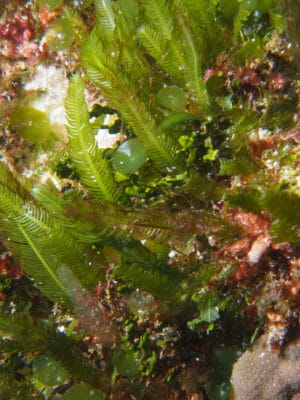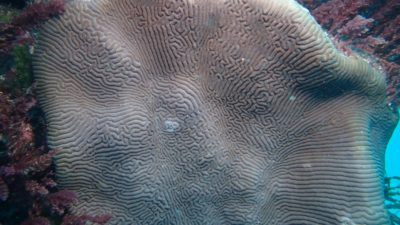Cold Water Diving
Shortly after sunrise the main dive boat, Calcutta, set out from Golden Shadow to survey a gently sloping spur and groove reef system on the south eastern side of Ill des Pins. The dive team and crew hunkered down out of the cold sea spray and wind for the forty minute transit out to the first dive site. It is noticeable how much more bundled up the scientific divers are on the New Caledonia trip compared to recent expeditions. Water temperatures recorded on dives frequently drop below 23°C (73°F). While this may sound warm, the water is actually relatively cold by tropical standards, and rapidly saps body warmth during the long days of survey. Hoods and layers of thick wet-suits are the order of the day, while one diver has resorted to a dry-suit to ensure comfort while he works – gear typically reserved for temperate waters. After cold water diving, researchers rapidly remove their wetsuits, towel off, and don dry clothes or wind breakers to elevate their core temperature. Positions in the sun are at a premium on surface intervals during cold water diving as divers do all they can to get warm before the second dive.

How Sea Surface Temperature Influences Coral Reefs
As we move from Ill des Pins to the atolls and reefs north of the main island (Grand Terre) in the coming weeks we expect to see temperatures rise by several degrees. This thermal trend provides a natural laboratory for studying how sea surface temperature influences coral reefs. It will be interesting to compare the biological communities in the northern reefs to those around Ill des Pins. Understanding the relationship of coral species to temperature is important. The trend of rising sea surface temperatures is predicted to continue under most climate change scenarios, and species with narrow thermal tolerance may change their distribution to cope with the changing thermal gradient.
Many algal species such as the green algae Caulerpa macrodisca identified during the surveys of Dr. Claude Payri are more commonly associated with temperate reefs to the south, such as around New Zealand, yet are found in Ill des Pins. We expect this species will be rare or absent in the reefs we will visit north of Grand Terre.

We also see differences in the coral community during our cold water diving. Coral species such as the Leptoria phrygia pictured below have been common on our surveys. On the Global Reef Expedition we have tended to see this coral at deeper sites where the temperature dips below ~26 C.

These are just a few examples we’ve seen during our cold water diving of how sea surface temperature influences coral reefs.
Photos by: 1 Ken Marks; 2 Andrew Bruckner; 3 Alex Dempsey